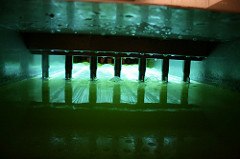 Tap water has to travel quite a distance in order to get from its source to your home. By the time water comes out of your faucets, it has been taken from a water supply, disinfected and sent through a winding network of pipes, and contaminants could have been introduced at any point in the process. Today we’re going to talk about the various sources of contamination during the water delivery process and why it’s a good idea to install a residential water treatment system as your last line of defense!
Tap water has to travel quite a distance in order to get from its source to your home. By the time water comes out of your faucets, it has been taken from a water supply, disinfected and sent through a winding network of pipes, and contaminants could have been introduced at any point in the process. Today we’re going to talk about the various sources of contamination during the water delivery process and why it’s a good idea to install a residential water treatment system as your last line of defense!
Contaminants occur naturally in source water
Your tap water comes from a large body of water like a lake or a river if you get it from a city, or from an underground water supply if you get it from a private well. All of these source water supplies contain a certain amount of naturally-occurring contaminants. For example, lakes and rivers contain bacteria and microorganisms, and they are susceptible to contamination from seasonal algae blooms. Underground wells, for their part, contain contaminants that exist in the bedrock where the wells are dug, including various minerals and heavy metals.
Water supplies can be contaminated by external sources
The water supplies that we discussed above can also be polluted by contaminants that do not originate in the supplies themselves. When it rains, for example, storm runoff can carry contaminants from the ground to nearby lakes, rivers or private wells. In addition, source water supplies might be located downstream from other water supplies where chemicals or wastewater are dumped, and those contaminants can make their way into the tap water supplies that connect to them.
Water treatment plants introduce chemicals to your water
Water treatment plants add disinfectants like chlorine or chloramine to the water that they draw from lakes and rivers in order to protect them from some (but not all) of the contaminants that we discussed above. This is good because it kills dangerous bacteria and pathogens that could cause waterborne diseases, but it also introduces a new category of contaminants to tap water.
When chlorine and chloramine interact with organic matter in water, they produce chemical byproducts known as trihalomethanes (THM’s). Exposure to these byproducts has been linked to respiratory problems, weakened immune systems, cardiovascular issues and an increased risk of bladder, kidney and colon cancers.
Water can pick up contaminants as it travels to your home
By the time water leaves the water treatment plant, it contains some of the contaminants that were there before the water was treated as well as a certain amount of THM’s. But there is still another way that contaminants can be introduced.
Water must travel through a network of public pipes before it gets to your home. Much of our nation’s water infrastructure was built over a century ago, and many of the pipes that it uses are deteriorating. As a result, contaminants can be introduced through cracks in public pipes or from cross-contamination with wastewater pipes when water mains break. These contaminants are introduced after water has already been treated by the city, so they are still present once that water gets to your home.
A residential water treatment system should be your last line of defense
As you can tell by now, the tap water that is delivered to your home might contain a wide variety of contaminants from multiple different sources. That’s why the only way to guarantee that your home has high-quality tap water is to install a residential water filtration system. A water filtration system will remove any of the contaminants that were introduced to your water up until the point that it reaches your home, and it will also take care of contaminants that are not effectively removed by your city’s water treatment plants.
If you have any questions about the sources of water contamination, or if you’d like a water system serviced or installed in your home ,contact EPA Water Consultants, your Eastern Pennsylvania and New Jersey dealer of water treatment systems. We provide service all over Eastern Pennsylvania and New Jersey, including towns like Ivyland, Jamison and Jeffersonville, PA.
